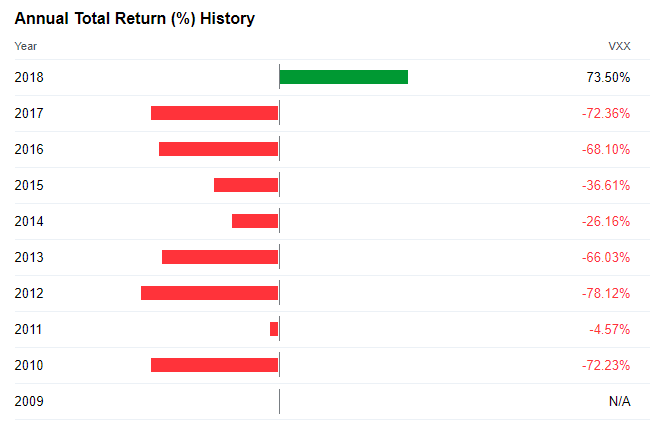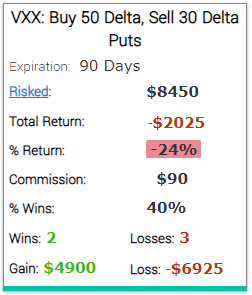
Shorting volatility in 2017 was easy money. In fact, it was easy money every year since 2010 when iPath S&P 500 VIX Short Term Futures TM ETN (NYSEARCA:VXX) has been created. Just go short VXX, buy puts or put debit spreads, and you would make money every year since 2010.
VXX History
Jill Malandrino, formerly of TheStreet.com writes it beautifully when she notes:
This has a negative impact on VXX as the strategy VXX was created to follow will consistently sell front-month futures and buy second-month futures.
This buying and selling of futures contracts is done to maintain a 30-day weighting between the two. Often this means that cheaper futures are being sold and more expensive futures being purchased. Eventually the second month future becomes the front month and the strategy will sell those contracts and begin purchasing the farther month.
Often when selling commences the price of the future is lower than when it was purchased and the vast majority of the time the front month is being sold for less premium than is being paid for second month.
To see how often VIX futures are in contango, or more precisely, how often VXX falls, here is an all-time price chart for trading VXX options:

Yep, the VXX is down 99.96% since inception. The reason is simply that VIX is almost always in contango
The Incredible Option Trade In VXX
in 2017, Ophir Gottlieb from CMLviz Trade Machine tested buying a put option spread in the VXX using the 90 day options over the last five-years. Here are the results of this VXX options trading strategy:

We see a 615% return, testing this over the last 5-years. Since we tested the 90 day options, that was 21 trades, in which 17 were winners and 4 were losers.
In fact, this strategy would be a winner every single year in 2010-2017.
2018 was very different
2018 was a very different year in many areas. In fact, 2018 was a first positive year for VXX since inception:

We tested the same VXX strategy in 2018. Here are the results:

That's right, for the first time since 2010, this strategy would produce negative returns. Which is not surprising, considering VXX was up 73.5% in 2018.
In fact, some periods in 2018 (specifically February and December) were so brutal that some funds blew up their clients account. The Spectacular Fall Of LJM Preservation And Growth describes one of those funds. Some of those funds were in business for over 20 years, but when volatility went through the roof in February, it was too much for them.
How to do it the right way
The way to create more consistent returns shorting volatility is to utilize spreads to hedge your position. At the simplest level, this modestly reduces profit potential but dramatically reduces loss potential. Even under the hedged scenario we can still create a 1:1 Risk:Reward on a trade that wins about 75% of the time. The key is when that wave of massive volatility hits the market seemingly overnight, we are dealing with a manageable loss rather than something catastrophic as one would expect in the unhedged scenario.
There are times where extreme volatility will give solid opportunity to short volatility unhedged, but it should always be done with a very small allocation. Patience and experience is also key with regard to entering, adjusting and exiting positions. In addition there are times where things get so out of touch with reality that the best course of action is to simply sit out for a bit and let the dust settle. It is likely that the most successful volatility traders use a combination of discretionary and systematic strategies in their trading.
Our PureVolatility portfolio (which is part of Creating Alpha service) produced double digit returns in 2018 during a first positive year for VXX since inception. Considering the overall market environment, this is an incredible performance.
The Incredible Winning Trade In SVXY describes one example of how the strategy performed in February when VIX doubled in a single day. Overall this trade produced almost 45% gain on margin or 26% gain on $10,000 portfolio.
A trade that was long SVXY, was a big winner after SVXY went down 90%+
Edited February 8, 2019 by Kim
What Is SteadyOptions?
Full Trading Plan
Complete Portfolio Approach
Diversified Options Strategies
Exclusive Community Forum
Steady And Consistent Gains
High Quality Education
Risk Management, Portfolio Size
Performance based on real fills
Non-directional Options Strategies
10-15 trade Ideas Per Month
Targets 5-7% Monthly Net Return
Recent Articles
Articles
Pricing Models and Volatility Problems
Most traders are aware of the volatility-related problem with the best-known option pricing model, Black-Scholes. The assumption under this model is that volatility remains constant over the entire remaining life of the option.
By Michael C. Thomsett, August 16

- Added byMichael C. Thomsett
- August 16
Option Arbitrage Risks
Options traders dealing in arbitrage might not appreciate the forms of risk they face. The typical arbitrage position is found in synthetic long or short stock. In these positions, the combined options act exactly like the underlying. This creates the arbitrage.
By Michael C. Thomsett, August 7

- Added byMichael C. Thomsett
- August 7
Why Haven't You Started Investing Yet?
You are probably aware that investment opportunities are great for building wealth. Whether you opt for stocks and shares, precious metals, forex trading, or something else besides, you could afford yourself financial freedom. But if you haven't dipped your toes into the world of investing yet, we have to ask ourselves why.
By Kim, August 7

- Added byKim
- August 7
Historical Drawdowns for Global Equity Portfolios
Globally diversified equity portfolios typically hold thousands of stocks across dozens of countries. This degree of diversification minimizes the risk of a single company, country, or sector. Because of this diversification, investors should be cautious about confusing temporary declines with permanent loss of capital like with single stocks.
By Jesse, August 6

- Added byJesse
- August 6
Types of Volatility
Are most options traders aware of five different types of volatility? Probably not. Most only deal with two types, historical and implied. All five types (historical, implied, future, forecast and seasonal), deserve some explanation and study.
By Michael C. Thomsett, August 1

- Added byMichael C. Thomsett
- August 1
The Performance Gap Between Large Growth and Small Value Stocks
Academic research suggests there are differences in expected returns among stocks over the long-term. Small companies with low fundamental valuations (Small Cap Value) have higher expected returns than big companies with high valuations (Large Cap Growth).
By Jesse, July 21

- Added byJesse
- July 21
How New Traders Can Use Trade Psychology To Succeed
People have been trying to figure out just what makes humans tick for hundreds of years. In some respects, we’ve come a long way, in others, we’ve barely scratched the surface. Like it or not, many industries take advantage of this knowledge to influence our behaviour and buying patterns.

- Added byKim
- July 21
A Reliable Reversal Signal
Options traders struggle constantly with the quest for reliable
By Michael C. Thomsett, July 20

- Added byMichael C. Thomsett
- July 20
Premium at Risk
Should options traders consider “premium at risk” when entering strategies? Most traders focus on calculated maximum profit or loss and breakeven price levels. But inefficiencies in option behavior, especially when close to expiration, make these basic calculations limited in value, and at times misleading.
By Michael C. Thomsett, July 13

- Added byMichael C. Thomsett
- July 13
Diversified Leveraged Anchor Performance
In our continued efforts to improve the Anchor strategy, in April of this year we began tracking a Diversified Leveraged Anchor strategy, under the theory that, over time, a diversified portfolio performs better than an undiversified portfolio in numerous metrics. Not only does overall performance tend to increase, but volatility and drawdowns tend to decrease:
Wednesday, April 15, 2020